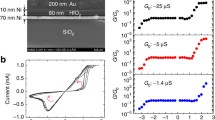Abstract
Although associative memory functions realized by CNNs have been widely demonstrated, most of those CNNs models don’t contain external inputs, and rarely have mentioned the implementation of actual circuit. In this work, we demonstrate the associative memory on the basis of three-cell CNNs with external inputs. Both single-associative memory and multi-associative memories can be realized by varying the initial values of the three-cell CNNs. In the physical circuit, different eight patterns can be stored and reconfigured by tuning very few resistances and the pre-stored patterns can be successfully retrieved.







Similar content being viewed by others
References
Elsen I, Kraiaiss KF, Krumbiegel D (1997) Pixel based 3D object recognition with Bi-directional associative memory. Int Conf Neural Netw 3:1679–1684
Liao XF, Yu JB, Chen GR (2002) Novel stability criteria for bi-directional associative memory neural networks with time delays. Int J Circuits Theory Appl 30:519–546
Sree HR, Phaneendra BR (1999) Global dynamics of bidirectional associative memory neural networks involving transmission delays and dead zones. Neural Netw 12:455–465
Jiang HJ, Teng ZD (2004) Boundedness and stability for non-autonomous bidirectional associative neural networks with delay. IEEE Trans CAS-II 51:174–180
Hu SG, Liu Y, Liu Z, Chen TP, Wang JJ, Yu Q, Deng LJ, Yin Y, Hosaka S (2015) Associative memory realized by a reconfigurable memristive Hopfield neural network. Nat Commun. http://dx.doi.org/10.1038/ncomms8522
Chua LO, Yang L (1988) Cellular neural networks: theory. IEEE Trans Circuits Syst I 35:1257–1272
Chua LO, Roska T (2002) Cellular neural networks and visual computing foundation and applications. Cambridge University Press, Cambridge
Liu D, Michel AN (1993) Cellular neural networks for associative memories. IEEE Trans Circuits Syst II 40:119–121
Liu D, Michel AN (1994) Sparsely interconnected neural networks for associative memories with applications to cellular neural networks. IEEE Trans Circuits Syst II 41:295–307
Brucoli M, Carnimeo L (1995) Discrete-time cellular neural networks for associative memories with learning and forgetting capabilities. IEEE Trans Circuits Syst I 42:396–399
Zeng Z, Wang J, Liao X (2004) Stability analysis of delayed cellular neural networks described using cloning templates. IEEE Trans Circuits Syst I 51:2313–2324
Grassi G (1997) A new approach to design cellular neural networks for associative memories. IEEE Trans Circuits Syst 44(9):835–838
Zhang H, Wang Z (2000) On the global asymptotic stability of delayed cellular neural networks. IEEE Trans Circuits Syst I 47:571–574
Huang T, Li C (2012) Robust exponential stability of uncertain delayed neural networks with stochastic perturbation and impulse effects. IEEE Trans Neural Netw Learn Syst 23:866–875
Ailong W, Liu L (2017) Mittag-Leffler stability of fractional-order neural networks in the presence of generalized piecewise constant arguments. Neural Netw 85:118–127
Song Q, Zhao Z (2015) Stability criterion of complex-valued neural networks with both leakage delay and time-varying delays on time scales. Neurocomputing 171:179–184
Song Q, Shu H (2017) Lagrange stability analysis for complex-valued neural networks with leakage delay and mixed time-varying delays. Neurocomputing 244:33–41
Civalleri PP, Gilli M (1993) On the dynamic behavior of two-cell cellular neural networks. Int J Circuits Theory Appl 21:451–471
Wu CW, Chua LO (1997) A more rigorous proof of complete stability of cellular neural networks. IEEE Trans Circuits Syst 44(4):370–371
Li XM, Hu LH (2003) On the complete stability of cellular neural networks with external inputs and bias. Acta Math Appl Sin 26(3):475–486
Liu Y, Liu W, Chen G (2012) Implementing dynamic reconfigurable CNN-based full-adder. In: The cellular nanoscale networks and their applications (CNNA), 2012 13th international workshop on components, circuits, devices and systems
Acknowledgements
This work was supported by Natural Science Foundation of Jiangsu Province, China. Grants No. BK20150880.
Author information
Authors and Affiliations
Corresponding author
Ethics declarations
Conflict of interest
The researcher claims no conflicts of interests.
Electronic supplementary material
Below is the link to the electronic supplementary material.
Rights and permissions
About this article
Cite this article
Liu, Y., Liu, W. & Wu, Y. Associative Memory Realized by Reconfigurable Coupled Three-Cell CNNs. Neural Process Lett 48, 1123–1134 (2018). https://doi.org/10.1007/s11063-017-9749-5
Published:
Issue Date:
DOI: https://doi.org/10.1007/s11063-017-9749-5




